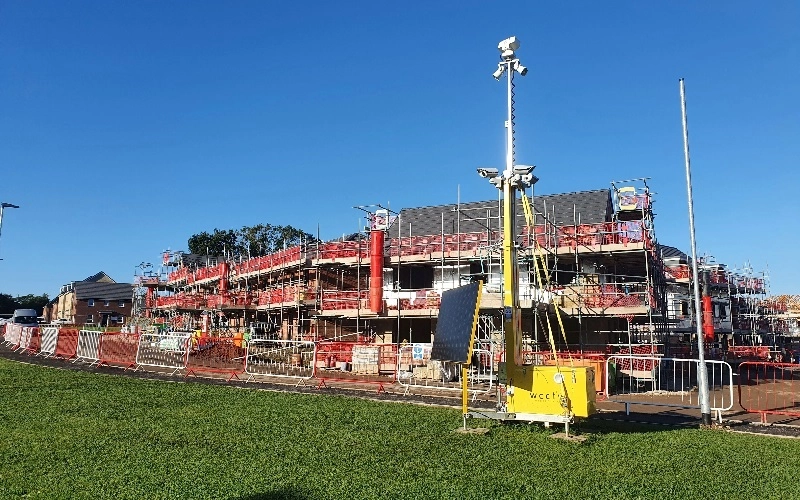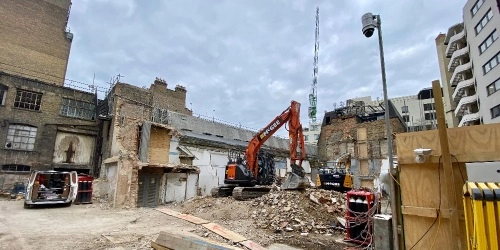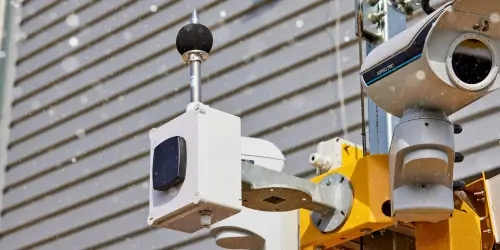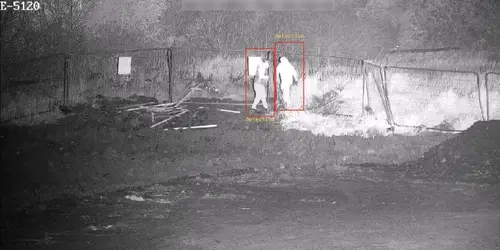Storing CCTV Tower footage securely is just as important as capturing it in the first place.
Without a reliable storage method, you could lose critical evidence, face delays in accessing footage or fall short of compliance requirements. This can undermine your site security and any investigations you need to carry out.
The stakes are particularly high when protecting construction projects, safeguarding public spaces or monitoring critical infrastructure.
In this guide, we’ll break down your storage options and give advice on how to find what works best for your site’s needs.
Types of Storage for CCTV Tower Footage
Here’s an overview of the 3 main approaches to storing CCTV Tower footage and their pros and cons.
On-site storage
On-site storage records and saves footage directly at your location using Network Video Recorders (NVRs) or Digital Video Recorders (DVRs). These devices are either built into your CCTV Tower or connected nearby, keeping all recordings physically present where your security cameras operate.
Pros:
- Gives you instant access to footage without relying on internet connectivity.
- Provides full control over storage hardware.
- Supports high-quality, uncompressed video for clearer evidence.
Cons:
- Makes you vulnerable to data loss if the camera equipment or built-in hard drives are stolen or damaged.
- Limits how much footage you can store before it is overwritten.
- Requires regular on-site maintenance and manual backups.
Cloud storage
Cloud-based storage sends the camera's footage over a secure mobile or internet connection to remote CCTV servers, where it's stored and managed off-site. This means you can access your recordings from anywhere with an internet connection, without having to visit the site.
Pros
- Supports remote monitoring so you can check live feeds or recordings without visiting the site.
- Allows you to increase the storage capacity as needed without having to upgrade on-site hardware.
- Protects your data from being lost due to theft or damage at the site.
Cons
- Requires a stable network connection for reliable uploads.
- Involves ongoing subscription costs that can increase with storage needs.
- May limit upload speeds if you have large volumes of high-resolution footage.
Hybrid storage
Hybrid storage combines on-site recording with cloud backups, giving you the benefits of both approaches. Footage is stored locally for quick access and sent to secure remote servers for added protection. This setup ensures you still have access to recordings even if one storage method fails.
Pros:
- Gives you fast on-site access while keeping a secure backup in the cloud.
- Protects your footage from local hardware failures, theft or damage.
- Lets you meet strict compliance or retention requirements more easily.
Cons:
- Costs more to set up and maintain than a single storage method.
- Requires you to manage both local and cloud systems effectively.
- Depends on network connectivity for the cloud backup element.
Factors to Consider When Choosing a Storage Option
Selecting the right security camera storage method for your CCTV Tower footage is about matching technology to your site’s needs, storage capacity requirements, security needs and budget.
Here's a breakdown of 5 crucial considerations you should think about before choosing.
Footage retention requirements
How long do you need to keep the video recordings? Some projects may only require a few days of footage, while others, such as those in the public sector or critical infrastructure, may need to retain it for months.
If your CCTV system's storage space can't hold the required amount of footage, it will start overwriting older recordings before you’ve had a chance to review or save them.
Accessibility
Consider how and where you need to access your footage. If you need remote access to review recordings, cloud or hybrid storage gives you greater flexibility since it allows you to log in from almost anywhere.
On-site storage may be fine if you only need local access, but it can be limiting if your team works across multiple locations or needs rapid retrieval in real-time.
Budget
Your budget will also influence your choice.
On-site security systems typically involve higher upfront costs for hardware, while cloud solutions spread costs over ongoing subscription fees. Hybrid solutions offer more security and flexibility but can be more expensive to set up and maintain.
Look beyond the purchase price and consider the total cost of ownership, including maintenance, upgrades and potential downtime, to understand the full cost of each option.
Compliance and data security
Each type of storage has its own risks, which you'll need to account and plan for.
With on-site storage, your footage is vulnerable if the physical equipment is stolen, vandalised or damaged, especially in remote or unsecured areas. If backups aren't taken regularly, you could lose critical evidence in a single incident.
For cloud storage, the main risks come from cyber threats. Storing footage online without strong encryption or secure login processes could expose you to data breaches or unauthorised access. If the cloud provider’s servers are compromised, sensitive recordings may be at risk.
Hybrid storage reduces some of these risks but adds complexity. If either the local system or cloud backup is poorly secured, you still have a weak point that could be exploited. Mismanaging access permissions or failing to monitor both systems could lead to compliance failures.
The storage option you choose should help you meet ISO and ESG standards while keeping your footage safe from loss, theft or misuse.
Site conditions
Your site's physical and environmental conditions can affect how well different storage options work.
For example, local storage faces problems from extreme heat, humidity or dust that can damage hard drives. You'll also need to guard against potential risks of theft or vandalism of the CCTV unit, which can lead to permanent data loss.
With cloud storage, your data is safe from physical damage and accessible from anywhere, but it depends on stable internet connectivity. Slow or interrupted connections can delay live monitoring or video retrieval.

How Temporary CCTV Towers Support Flexible Storage Needs
Our Temporary CCTV Towers, powered by Stellifii, are built to accommodate the unique storage requirements of various projects and sites.
- Eco Tower: Designed for sites with limited or phased power, this unit features an integrated video recording unit that can capture up to 30 days of footage on a single charge.
- Smart Tower: Offers onboard recording with up to 4TB of local storage. It can simultaneously record and store footage from its 4 cameras.
- Solar Fuel Cell Tower: Ideal for long-term, off-grid projects, this Tower provides uninterrupted surveillance and storage for up to 20 weeks between fuel cell refills.
- Thermal Solar Tower: Delivers early detection and live response, with recorded footage and alerts stored automatically.
- Network Rail Tower: PADS-approved for rail infrastructure, this Tower provides local recording with up to 4TB of storage, giving you a visual record of trackside activity and engineering works.
- Traffic Management Tower: Stores all recordings locally, allowing you to review footage of incidents, lane closures and diversions for post-event analysis.
- The Hornet: This compact PID system records short video clips when motion is detected, storing the footage locally on encrypted SD cards with an option for cloud upload.
All CCTV Towers are supported by our fully-managed security service. We manage the installation, monitoring and regular maintenance, keeping your site secure and handling all storage requirements so your team can focus on other priorities.
Contact us today to discuss how we can help guard your site(s) against known and emerging threats.
FAQs About Data Storage For CCTV Towers
What are the different types of CCTV storage?
Common types include:
- DVR: Stores footage from analogue CCTV cameras. It uses hard drives and is often limited to local, on-site access.
- NVR: Works with IP cameras. It stores footage digitally and can allow remote access over the internet.
- Network-Attached Storage (NAS): A dedicated network storage device that multiple systems can access. Useful for large-scale setups.
- Serial Advanced Technology Attachment (SATA) drives: Internal hard drives used in DVRs, NVRs or standalone servers for direct storage.
- Cloud CCTV storage: Stores footage online, offering remote access, automatic backups and scalability.
- SD cards: Built into some CCTV cameras for short-term or backup storage.
- Hybrid storage: Combines local (NVR, DVR) and cloud storage for redundancy.
IP camera cloud storage: Lets IP cameras send footage directly to the cloud without needing an NVR, making it easier to access and manage recordings remotely.
How long should security camera footage be stored?
In the UK, there are no fixed legal rules for how long video footage must be kept. Under the Data Protection Act 2018 and UK GDPR, the main requirement is to store recordings only for as long as they're needed.
Your retention period should reflect why you collected the footage in the first place. For example, if your goal is to spot and respond to incidents quickly, you may only need to store recordings for a short time. If you’re protecting a high-risk site, monitoring for criminal activity or working in a regulated sector, you may need to keep footage for longer to meet security or compliance needs.
The key is to set a clear retention policy based on your operational requirements, legal obligations and the likelihood of needing older footage for investigations.
Note: If the footage relates to a crime, ongoing investigation or legal case, you should keep it until the matter is resolved, even if that means holding it beyond your standard retention window.
How secure is cloud-based CCTV storage?
Cloud-based CCTV storage can be very secure if the provider uses strong data protection measures. Most reputable providers use encryption both when the footage is being sent (in transit) and when it is saved on their servers (at rest). This means that even if the data is intercepted, it cannot be read without the encryption key.
What are the benefits of storing CCTV footage?
Storing your CCTV footage provides the following benefits:
- Provides evidence for investigations and legal cases.
- Improves security by allowing patterns or risks to be identified and addressed proactively.
- Helps protect people, property and assets by ensuring incidents are documented and can be acted upon.




